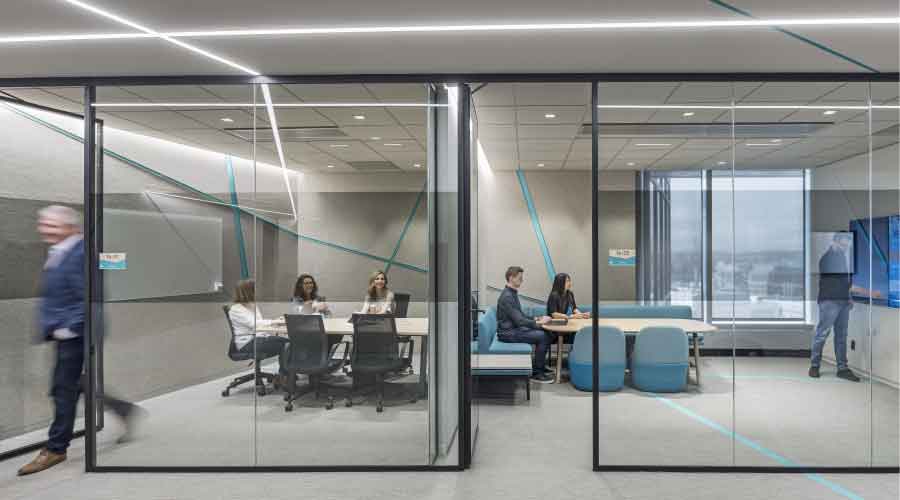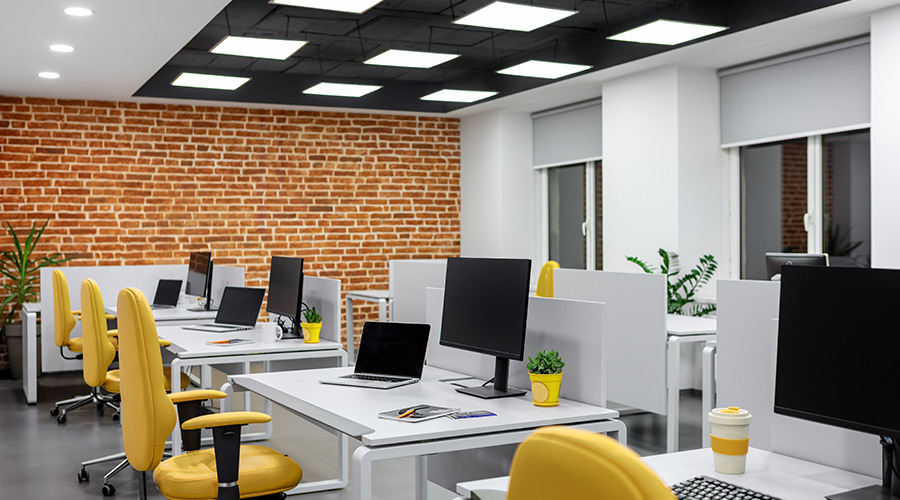 Photography © Anton Grassl
Photography © Anton GrasslAcoustical Strategies for Occupants’ Return to the Office
To attract workers back to the office, facilities need to remove noisy distractions
As the country moves past the COVID-19 pandemic shutdown of recent years, much attention for facility managers has been focused on how to lure employees back to the office workplace. When it comes to workplace acoustics, the age-old concerns of distracting noise, poor speech privacy, and less-than-ideal electronic conferencing systems may emerge as serious impediments to employees as they consider a move from their home workspaces back to the corporate office.
Since the onset of COVID-19, many employees have adapted to working from home, using innovative technologies for accessing office computers and conducting meetings via Zoom or Teams. When it comes to acoustics, the fortunate have created home office environments that are relatively quiet and private, perhaps in a basement or spare bedroom.
Understandably, a good percentage of remote workers may not relish the prospect of returning to an office where scant attention has been paid to the acoustical environment with resulting distractions in open office areas, poor acoustical privacy in closed offices and conference rooms, and teleconferencing systems with poor speech clarity.
As employers look for ways to attract workers back to the office, these three recommendations are intended to improve post-COVID workplace acoustics. Remote workers who are dealing with less-than-ideal home office acoustics (such as barking dogs, noisy kids, etc.) may be especially interested in returning to an office where acoustical concerns have been successfully addressed.
Open office acoustics
Unfortunately, employees in many open offices have to contend with high levels of distracting noise. This is due to a number of factors, chief among them the current trend toward “bench” style workstations with little or no separation between workers. People have adapted by wearing noise-cancelling headsets or by seeking refuge in a closed huddle or conference room. The truth is, a few design changes can improve acoustical conditions significantly:
- Ceiling finishes: Make sure that 100 percent of the open office ceilings are highly sound absorbing, in the range of Noise Reduction Coefficient (NRC) 0.70 or higher. There are many design options, including glass fiber lay-in tiles, felt baffles, and spray-on cellulose.
- Workstation barriers: Workers who require freedom from distraction should be separated by barriers that break the line-of-sight between adjacent colleagues. Barriers with glass tops can be less imposing visually but still provide the desired acoustical privacy. Workers with sit/stand desks should return their workstations to the lower position before participating in online meetings.
- Electronic sound masking: It may seem logical that quiet background noise levels in open office areas would enhance the work environment, but the opposite is actually true. In a quiet setting, even a low level of conversations or activity in nearby areas stands out distinctly, as audible distractions. Adding a subtle, but clearly audible, level of electronic background sound (similar to the character of HVAC airflow) helps to make sounds in the open office significantly less distracting. In addition, recent advancements have been made with sound masking and soundscaping, presenting designers with new opportunities to shape the users’ experience.
There is no denying that the level of speech privacy that can be achieved by implementing these design enhancements (often defined as “normal” privacy or “freedom from distraction”) cannot match the privacy of a well isolated home office, but good acoustical design can make the transition back to an open office less jarring acoustically.
Nicole Cuff, PE, LEED AP BD+C, is a Principal at Acentech. She has over 20 years of consulting experience managing all aspects of architectural acoustics including room acoustics, sound isolation, and MEP noise and vibration control, and environmental noise mitigation in communities.
Thomas McGraw, LEED AP is a Principal and Corporate/Commercial Market Leader at Acentech. He has over 24 years of consulting experience and is responsible for the management of all project phases, from programming, schematic design, and specifications development to construction administration.
Related Topics:













